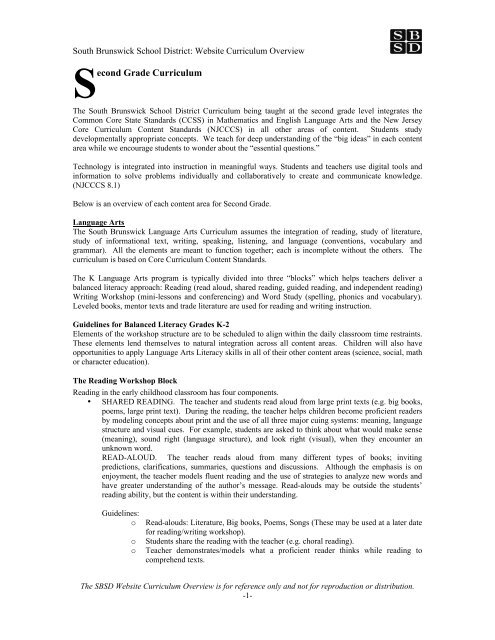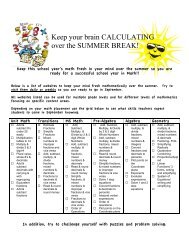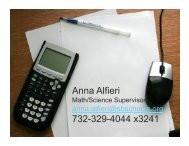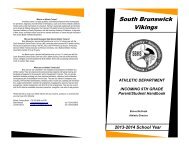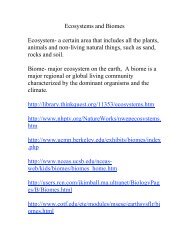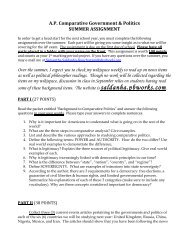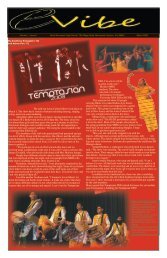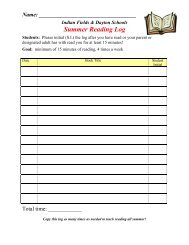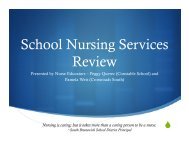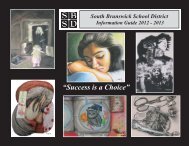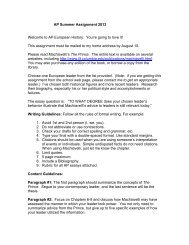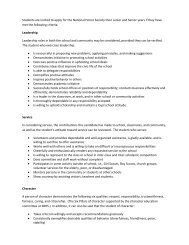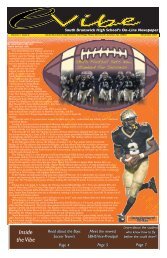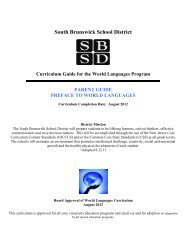Second Grade Curriculum - South Brunswick Public Schools
Second Grade Curriculum - South Brunswick Public Schools
Second Grade Curriculum - South Brunswick Public Schools
Create successful ePaper yourself
Turn your PDF publications into a flip-book with our unique Google optimized e-Paper software.
<strong>South</strong> <strong>Brunswick</strong> School District: Website <strong>Curriculum</strong> Overview<br />
S<br />
econd <strong>Grade</strong> <strong>Curriculum</strong><br />
The <strong>South</strong> <strong>Brunswick</strong> School District <strong>Curriculum</strong> being taught at the second grade level integrates the<br />
Common Core State Standards (CCSS) in Mathematics and English Language Arts and the New Jersey<br />
Core <strong>Curriculum</strong> Content Standards (NJCCCS) in all other areas of content. Students study<br />
developmentally appropriate concepts. We teach for deep understanding of the “big ideas” in each content<br />
area while we encourage students to wonder about the “essential questions.”<br />
Technology is integrated into instruction in meaningful ways. Students and teachers use digital tools and<br />
information to solve problems individually and collaboratively to create and communicate knowledge.<br />
(NJCCCS 8.1)<br />
Below is an overview of each content area for <strong>Second</strong> <strong>Grade</strong>.<br />
Language Arts<br />
The <strong>South</strong> <strong>Brunswick</strong> Language Arts <strong>Curriculum</strong> assumes the integration of reading, study of literature,<br />
study of informational text, writing, speaking, listening, and language (conventions, vocabulary and<br />
grammar). All the elements are meant to function together; each is incomplete without the others. The<br />
curriculum is based on Core <strong>Curriculum</strong> Content Standards.<br />
The K Language Arts program is typically divided into three “blocks” which helps teachers deliver a<br />
balanced literacy approach: Reading (read aloud, shared reading, guided reading, and independent reading)<br />
Writing Workshop (mini-lessons and conferencing) and Word Study (spelling, phonics and vocabulary).<br />
Leveled books, mentor texts and trade literature are used for reading and writing instruction.<br />
Guidelines for Balanced Literacy <strong>Grade</strong>s K-2<br />
Elements of the workshop structure are to be scheduled to align within the daily classroom time restraints.<br />
These elements lend themselves to natural integration across all content areas. Children will also have<br />
opportunities to apply Language Arts Literacy skills in all of their other content areas (science, social, math<br />
or character education).<br />
The Reading Workshop Block<br />
Reading in the early childhood classroom has four components.<br />
• SHARED READING. The teacher and students read aloud from large print texts (e.g. big books,<br />
poems, large print text). During the reading, the teacher helps children become proficient readers<br />
by modeling concepts about print and the use of all three major cuing systems: meaning, language<br />
structure and visual cues. For example, students are asked to think about what would make sense<br />
(meaning), sound right (language structure), and look right (visual), when they encounter an<br />
unknown word.<br />
READ-ALOUD. The teacher reads aloud from many different types of books; inviting<br />
predictions, clarifications, summaries, questions and discussions. Although the emphasis is on<br />
enjoyment, the teacher models fluent reading and the use of strategies to analyze new words and<br />
have greater understanding of the author’s message. Read-alouds may be outside the students’<br />
reading ability, but the content is within their understanding.<br />
Guidelines:<br />
o<br />
o<br />
o<br />
Read-alouds: Literature, Big books, Poems, Songs (These may be used at a later date<br />
for reading/writing workshop).<br />
Students share the reading with the teacher (e.g. choral reading).<br />
Teacher demonstrates/models what a proficient reader thinks while reading to<br />
comprehend texts.<br />
The SBSD Website <strong>Curriculum</strong> Overview is for reference only and not for reproduction or distribution.<br />
-1-
<strong>South</strong> <strong>Brunswick</strong> School District: Website <strong>Curriculum</strong> Overview<br />
o<br />
o<br />
Whole group discussion and turn and talk sharing with peers to facilitate<br />
comprehension of text.<br />
Teacher demonstrates word study strategies and skills.<br />
• WHOLE CLASS MINI LESSONS. The teacher provides whole class mini lessons determined by<br />
the needs of the group and the district curriculum.<br />
Guidelines:<br />
o Reread a section of familiar text to demonstrate and model what a proficient reader<br />
thinks while reading to comprehend text.<br />
o Provide direct instruction in the use of comprehension strategies, fluency, vocabulary<br />
and author’s craft strategies.<br />
o Whole group discussion and/or turn and talk sharing with peers, to facilitate<br />
comprehension of text.<br />
o Use strategies to help students record their thinking. (e.g. anchor charts, stop and<br />
jots, sticky notes).<br />
• GUIDED READING. The teacher works with a small group of children to study a book<br />
appropriate to the specific needs of that group. The composition of these groups is flexible and<br />
reflects the needs and interests of the children. Many of the strategies and skills presented during<br />
shared reading are reinforced in small group instruction where students receive greater attention<br />
and support. Through mini-lessons and guided reading instruction, students learn to apply<br />
comprehension strategies such as predicting, making connections and retelling a story.<br />
Guidelines:<br />
o Small, flexible groups of students with similar needs (up to 6 students) meet for<br />
instruction and guided reading of text.<br />
o Teacher provides direct instruction of skills and strategies. Lesson may support<br />
whole group mini-lesson.<br />
o<br />
o<br />
Use one-to-one conferences & anecdotal notes to support instruction.<br />
The goal of guided reading is to teach strategies that develop independent readers of<br />
text.<br />
• STRUCTURED INDEPENDENT READING: Independent reading gives students the<br />
opportunity to apply the skills and strategies they have learned in shared reading and guided<br />
reading groups. Students are taught strategies to self-select books to read on their own.<br />
Guidelines:<br />
o Independent reading (build stamina from 10 to 30 minutes- as appropriate).<br />
o Partner reading<br />
o<br />
o<br />
Independent practice of the concept/skill demonstrated in reading mini-lesson.<br />
Extend the Meaning of Text: through oral discussion, drawing, diagramming, drama<br />
or written response to reading.<br />
The Writing Workshop Block<br />
Students in <strong>Grade</strong>s K-2 explore what it means to be a writer. They have opportunities to choose topics,<br />
make their writing beautiful with writer’s craft and revise and edit writing for an audience. Teachers use<br />
the “Writing Workshop” approach to teach students the joy and purposes of writing. During Writer’s<br />
Workshop, there are mini-lessons to deliver instruction and independent writing to provide time for<br />
practice. While students write, teachers conduct individual conferences to help raise the quality of each<br />
child’s writing skills.<br />
Throughout <strong>Grade</strong>s K-2, students write personal narrative “Small Moment” stories and explore various<br />
non-fiction genres. These include “All-about” and “How-to” selections as well as some beginning research<br />
projects. In addition, students explore the language of poetry and study “mentor writers” to help build their<br />
skills.<br />
The SBSD Website <strong>Curriculum</strong> Overview is for reference only and not for reproduction or distribution.<br />
-2-
<strong>South</strong> <strong>Brunswick</strong> School District: Website <strong>Curriculum</strong> Overview<br />
• WRITING MINI LESSONS. Teacher directed, whole group instruction determined by the<br />
assessed needs of the group and the district curriculum.<br />
Guidelines:<br />
o Procedural, craft, and/or skill lessons are taught during various genres studies.<br />
o Shared writing experiences/ Interactive writing.<br />
o<br />
o<br />
Teacher’s writing (used for direct instruction or modeling).<br />
Use of mentor or touchstone texts (may be the same texts read during the daily readalouds.<br />
Writing Workshop Components:<br />
o Connection<br />
o Explicate Instruction<br />
o Active Engagement<br />
o Link<br />
o<br />
o<br />
Teacher meets with students in one-to-one conferences or flexible, small group strategy<br />
groups.<br />
Students share writing with writing partners or during group shares.<br />
• INDEPENDENT WRITING<br />
Writing Guidelines:<br />
o Students choose topics and plan writing.<br />
o Students have daily opportunities for independent writing (build stamina from 10 to 30<br />
minutes- as appropriate).<br />
o Students should show evidence of use of strategies from recent mini-lessons and<br />
conferences.<br />
Conferencing Guidelines<br />
o One-on-one conferences<br />
o Small group conferences<br />
o Anecdotal notes to track progress<br />
• SHARING OPPORTUNITIES FOR WRITERS<br />
Guidelines:<br />
o Sharing/discussion to bring closure to the writing workshop by reflecting on the day’s<br />
writing and /or some aspect of direct instructions.<br />
o Students have opportunities to share some aspect of their writing with partners or whole<br />
group.<br />
The Word Study Block (Spelling/Phonics/Vocabulary)<br />
The District uses a systematic and explicit phonics, spelling and vocabulary program called, Words Their<br />
Way. Students learn the relationship between letters and letter sounds and how letter patterns and word<br />
chunks, such as diagraphs, prefixes and suffixes impact spelling. In addition, vocabulary lessons are based<br />
on high frequency words, multiple meaning words, multi-syllabic words and words from other content<br />
areas. Students are grouped and regrouped throughout the year based on spelling assessments and written<br />
samples.<br />
Handwriting<br />
The District teaches handwriting through direct instruction and independent practice of letter formation and<br />
spacing.<br />
The SBSD Website <strong>Curriculum</strong> Overview is for reference only and not for reproduction or distribution.<br />
-3-
<strong>South</strong> <strong>Brunswick</strong> School District: Website <strong>Curriculum</strong> Overview<br />
Mathematics<br />
The <strong>South</strong> <strong>Brunswick</strong> Mathematics Program is based on a well-articulated curriculum that is aligned with<br />
CCSS: 1.NBT.1, 1.NBT.2, 1.NBT.3, 1.NBT.4; 2.G.1, 2.G.2, 2.G.3; 2.OA.3, 2.OA.4; 2.MD.1, 2.MD.2,<br />
2.MD.3, 2.MD.4, 2.MD.5, 2.MD.6, 2.MD.7, 2.MD.9, 2.MD.10; 2.OA.1, 2.OA.2, 2.NBT.5, 2.NBT.6,<br />
2.NBT.7, 2.NBT.8, 2.NBT.9; and 2.MD.6, 2.MD.8. The curriculum has interwoven technology, and is<br />
connected in meaningful ways to other curriculum and real life.<br />
In each grade, we build upon the knowledge and skills learned in previous grades in order to provide a<br />
strong foundation for later learning.<br />
<strong>Second</strong> grade topics of study are as follows:<br />
• Place Value<br />
• Addition & Subtraction<br />
• Number & Operations in Base 10<br />
• Foundations for Multiplication<br />
• Measurement & Time<br />
• Geometry<br />
2nd <strong>Grade</strong> Essential Questions Enduring Understandings<br />
Place Value<br />
Addition &<br />
Subtraction/Numbers<br />
and Operations in<br />
Base 10<br />
Foundations for<br />
Multiplication<br />
Measurement &<br />
Time<br />
Geometry<br />
• How does a number’s position<br />
affect its value?<br />
• How are place value patterns<br />
repeated in numbers?<br />
• What strategies can be used to<br />
find sums and differences?<br />
• How do mathematical<br />
operations relate to each other?<br />
• What are strategies for making a<br />
reasonable estimation?<br />
• How are patterns used to<br />
communicate mathematical<br />
concepts?<br />
• What is the relationship<br />
between products and sums?<br />
• Why is it important to use<br />
standard units of measure?<br />
• How and why do we organize<br />
information?<br />
• How is telling time used in our<br />
daily lives?<br />
• How are geometric properties<br />
used to solve problems in<br />
everyday life?<br />
• Our Base 10 number system<br />
determines a digits value.<br />
• Flexible methods of computation<br />
involve grouping numbers in strategic<br />
ways.<br />
• Estimation is a way to get an<br />
approximate answer.<br />
• Proficiency with basic facts aids<br />
estimation and computation of larger<br />
and smaller numbers.<br />
• There is a relationship between<br />
multiplication and addition.<br />
• Multiplication can be a more efficient<br />
strategy for solving problems.<br />
• There is a connection between the<br />
numerical concept of multiplication<br />
and the geometric concept of area<br />
(arrays).<br />
• Standard units provide a common<br />
language for communicating<br />
measurement accurately.<br />
• Data can be organized in meaningful<br />
ways so that it can be interpreted and<br />
analyzed.<br />
• Time is measured in hours and<br />
minutes.<br />
• Objects can be described, compared,<br />
and classified by geometric attributes.<br />
• Many geometric shapes can be<br />
divided into equal parts.<br />
The SBSD Website <strong>Curriculum</strong> Overview is for reference only and not for reproduction or distribution.<br />
-4-
<strong>South</strong> <strong>Brunswick</strong> School District: Website <strong>Curriculum</strong> Overview<br />
In second grade, students will extend their understanding of the base-ten system. This includes ideas of<br />
counting in fives, tens, and multiples of hundreds, tens, and ones. They will spend time examining number<br />
relationships involving these units, including comparing and sequencing numbers within 1000. Students<br />
will understand multi-digit numbers (up to 1000) written in base-ten notation, recognizing that the digits in<br />
each place represent amounts of thousands, hundreds, tens, or ones (e.g., 853 is 8 hundreds + 5 tens + 3<br />
ones). Students will use their understanding of numerical operations to develop fluency with addition and<br />
subtraction within 100. They will then solve problems within 1000 by applying their understanding of<br />
models for addition and subtraction. Students will develop, discuss, and use efficient, accurate, and<br />
generalize-able methods to compute sums and differences of whole numbers in base-ten notation, using<br />
their understanding of place value and the properties of operations. They will select and accurately apply<br />
methods that are appropriate for the context and the numbers involved to mentally calculate sums and<br />
differences for numbers. Building on these ideas, students will explore number relationships and patterns<br />
to form the foundations for multiplication in later grades. Students will participate in this early exploration<br />
of multiplication through exploring hundreds charts, rectangular arrays, and repeated addition.<br />
In measurement, students will recognize the need for standard units of measure (centimeter and inch) from<br />
classroom exploration with measurement. They will use rulers and other measurement tools with the<br />
understanding that linear measure involves a repetition of units. They will recognize that the smaller the<br />
unit, the more repetitions they need to cover a given length.<br />
In geometry, students will describe and analyze shapes by examining their sides and angles. Students will<br />
investigate, describe, and reason about decomposing and combining shapes to make other shapes. Through<br />
building, drawing, and analyzing two- and three-dimensional shapes, students will develop a foundation for<br />
understanding area, volume, congruence, similarity, and symmetry in later grades. Students will also begin<br />
to explore fractions by segmenting shapes into equal pieces.<br />
Materials from the Scott Foresman and TERC Math Investigations series are in use in the <strong>Second</strong> <strong>Grade</strong><br />
Math program. Manipulatives, computer software, and calculators are supplementing the curriculum. Over<br />
the course of the year, a second grade child will take part in a math extension program called “Math for All<br />
Kinds of Minds” in which students will be regrouped by ability across the grade level to work on problembased,<br />
long-range projects that will provide additional challenge and enrichment. As one component of our<br />
Gifted & Talented Services, each year we identify students in Kindergarten through <strong>Grade</strong> Five who may<br />
be ready for mathematics acceleration (that is, accelerating a full grade level in math). Multiple criteria,<br />
along with recommendations, are utilized to make such decisions on student placement.<br />
Science<br />
It is the intention of <strong>South</strong> <strong>Brunswick</strong> <strong>Schools</strong> to graduate all of its students with the scientific knowledge,<br />
skills and habits of mind needed to be lifelong-learners, critical thinkers, effective communicators and wise<br />
decision-makers. Students will develop and use the skills necessary for full participation in a world shaped<br />
by science and technology.<br />
<strong>Second</strong> grade students study the life, earth and physical sciences based on the 2009 NJCCCS: 5.1.4.A.2,<br />
5.1.4.A.3, 5.1.4.B.1-B.4, 5.1.4.C.1, 5.1.4.C.3, 5.1.4.D.1-D.3, 5.2.2.B.1, 5.2.2.C.1-C.3, 5.3.2.A.1, 5.3.4.A.2,<br />
5.3.2.B.1, 5.3.2.B.2, 5.3.2.C.1-C.3, 5.3.2.D.1, 5.3.2.D.2, 5.3.4.D.1, 5.3.2.E.1, 5.3.2.E.2, 5.4.2.G.3,<br />
5.4.4.B.1, 5.4.2.C.1, 5.4.4.C.1, and 5.4.4.C.2.<br />
• Life Cycle of Butterfly (life) ~ What changes do living things go through during their lives? How<br />
do living things affect their environment and how do changes in the environment affect living<br />
things?<br />
• Rocks & Soil (earth) ~What is the Earth made of? What makes up land? What do the rocks and<br />
soils around us look like? Why are rocks and minerals important resources? What is a fossil?<br />
• Properties of Light (physical) ~ What is light? What are the sources of light? How does light<br />
travel?<br />
The SBSD Website <strong>Curriculum</strong> Overview is for reference only and not for reproduction or distribution.<br />
-5-
<strong>South</strong> <strong>Brunswick</strong> School District: Website <strong>Curriculum</strong> Overview<br />
Social Studies<br />
The expectation is that all the students of <strong>South</strong> <strong>Brunswick</strong> will develop the social studies skills and<br />
knowledge they will need to be active, informed, responsible citizens and contributing members of their<br />
communities. The students will understand history as it relates to the present and future of their lives.<br />
<strong>Second</strong> grade students study the “here and now” as it relates to communities and citizenship. <strong>Grade</strong> 2<br />
students continue with the learning on belonging and neighborhoods by going deeper in their study of<br />
communities, past and present. Students consider how the people in their community contribute to the<br />
environment and economy. Meanwhile understanding that geography is a way of understanding the<br />
relationship between people and the world.<br />
Additionally, students will study the right and responsibilities of American citizens and the impact on their<br />
community and that symbols represent values and ideas that are important to a group of people.<br />
This study is based on the 2009 NJCCCS 6.1.A (Skills), 6.2.A (Civics), 6.4 (US/NJ History), 6.5<br />
(Economics) and 6.6 (Geography).<br />
• Communities~ How do communities meet the needs of their members?<br />
• Citizenship~ Choices citizens make affect their community/world. How can the choices citizens<br />
make affect their community and the world? What makes a good leader? How do citizens show<br />
patriotism? What is the importance of American symbols?<br />
• Geography~ How do we use maps and globes to understand our world? How does geography<br />
impact people; how do people impact geography? Personal maps, finding places, understanding<br />
and using directions, using maps and globes, identifying map features, and landforms.<br />
• Current Events<br />
Current Events are integrated into the curriculum and taught as applicable<br />
Health Education<br />
<strong>South</strong> <strong>Brunswick</strong> students need to be health literate, especially in response to all the input they receive from<br />
the media and society. Our District’s Health curriculum is firmly based on this teaching of “wellness”<br />
which can be defined as a “way of life.” Our goal is to help students learn the lessons of wellness and to<br />
encourage them to take responsibility for their own health and to make informed choices about their health<br />
now – and in the future. The <strong>Second</strong> <strong>Grade</strong> Health curriculum is based on 2009 NJCCCS and addresses all<br />
relevant standards for second grade with particular emphasis on 2.1A, 2.1.B, 2.1.D, 2.1.E, 2.2.B, and<br />
2.2.E.1.<br />
In <strong>Second</strong> <strong>Grade</strong>, Health is collaboratively taught by the classroom teacher, the nurse, the counselor, and<br />
the PE teacher.<br />
• Personal Safety (differentiating between swell secrets and tell secrets)<br />
• Nutrition (food groups, nutritional value, making healthy choices)<br />
• Disability Awareness (people with disabilities have the same hopes and dreams, talents and needs,<br />
feelings and goals as anyone else. With accommodations and education, they can achieve all they<br />
set out to accomplish)<br />
• Clicky (cyber safety and personal information)<br />
World Language<br />
<strong>South</strong> <strong>Brunswick</strong> School District wants students to demonstrate a positive attitude toward other languages<br />
and cultures, demonstrate motivation to learn languages, show confidence in their ability to learn and<br />
communicate through listening comprehension, accurate pronunciation, and some basic interpersonal<br />
communication.<br />
An education in world languages fosters a population that:<br />
• Communicates in more than one language with the levels of language proficiency that are required<br />
to function in a variety of occupations and careers in the contemporary workplace.<br />
The SBSD Website <strong>Curriculum</strong> Overview is for reference only and not for reproduction or distribution.<br />
-6-
<strong>South</strong> <strong>Brunswick</strong> School District: Website <strong>Curriculum</strong> Overview<br />
• Exhibits attitudes, values, and skills that indicate a positive disposition and understanding of<br />
cultural differences and that enhance cross-cultural communication.<br />
• Values language learning as a global literacy as well as for its long-term worth in fostering<br />
personal, work-related, and/or financial success in our increasingly interconnected world.<br />
<strong>South</strong> <strong>Brunswick</strong> uses the SALSA program in the K-2 classes, a videotape series (the tapes are about 15<br />
minutes in length and feature the Spanish language through well-known and well-loved children’s fairy<br />
tales) with accompanying mini-lessons that are taught by the classroom teacher with support from the<br />
world language teachers. Teachers then use the language in their daily routines and instruction wherever<br />
meaningful and purposeful.<br />
<strong>Second</strong> <strong>Grade</strong> students study the following SALSA II Episodes (31- 42):<br />
• Jack and the Cornstalk (El maíz)<br />
• Three Little Pigs (Los tres creditos)<br />
Art<br />
The Arts bring an important dimension to the educational program of the schools. Arts education draws<br />
upon personal feelings and experience as well as on logical and intellectual thought.<br />
Students in <strong>Grade</strong>s K-2 receive Art instruction one day per week as part of their Special Subject/Integrated<br />
Arts schedule. Their curriculum is based on the 2009 NJCCCS for Visual and Performing Arts: 1.1<br />
Creation, 1.2 History of Arts and Culture, 1.3 Performance, and 1.4 Aesthetic Response and Critique.<br />
Students in K-2 are introduced to the concepts and principles of color, shape, form, line, texture, and<br />
pattern. They use a variety of media and materials as appropriate for their grade level. The caring Art<br />
environment fosters freethinking, risk-taking, inspiration, and critique. Students are introduced to artists<br />
and artwork that connects to the themes of family, community, culture and time periods.<br />
Music<br />
The <strong>South</strong> <strong>Brunswick</strong> Elementary Music <strong>Curriculum</strong> is designed to allow students to experience music<br />
through many different venues such as singing, movement, games and activities, classroom instruments,<br />
composition and performance. Students learn that music is all around us. Music reflects life, builds a sense<br />
of community and helps define cultural identity. It is an art form and a form of entertainment. Students will<br />
understand that music is a universal language and music allows us to transcend time.<br />
Students in <strong>Grade</strong>s K-2 receive music instruction one day a week as part of their Special Subject/Integrated<br />
Arts schedule. Their curriculum is based on the 2009 NJCCCS for Visual and Performing Arts: 1.1<br />
Creation, 1.2 History of Arts and Culture, 1.3 Performance, and 1.4 Aesthetic Response and Critique. Over<br />
the year, the students study musical opposites, beat, rhythm, pitch/melody, movement, singing voice vs.<br />
speaking voice, listening skills, performance etiquette and decorum.<br />
Essential Questions for the K-2 general music curriculum include:<br />
• In what ways does rhythm impact how we hear/feel music?<br />
• How does rhythm make you feel?<br />
• Where else can you find rhythm?<br />
• What is the relationship between melody and speech?<br />
• How does melody make you feel?<br />
• Why do we like the music we like?<br />
• How does music impact our lives?<br />
• Is all sound music?<br />
• Why do we listen to music?<br />
The SBSD Website <strong>Curriculum</strong> Overview is for reference only and not for reproduction or distribution.<br />
-7-
<strong>South</strong> <strong>Brunswick</strong> School District: Website <strong>Curriculum</strong> Overview<br />
Physical Education (PE)<br />
Physical activity is critical to the development and maintenance of good health. The goal of physical<br />
education is to develop physically educated individuals who have the knowledge, skills, and confidence to<br />
enjoy a lifetime of healthful physical activity. It is our goal that our students will know the benefits of their<br />
choice to be involved in physical activity and have a mindset that values physical activity and its benefits in<br />
sustaining healthy lifestyles.<br />
Program Delivery<br />
Our Physical Education gymnasiums are effective 2009 NJCCC standards-based environments that foster<br />
understanding of physical fitness, skill development, competition and cooperation through a meaningful<br />
content that provides:<br />
• Instruction in a variety of motor skills that are designed to enhance the physical, mental, and<br />
social/emotional development of every child.<br />
• Fitness education and assessment to help children understand, improve, and/or maintain their<br />
physical well being.<br />
• Development of cognitive concepts about motor skill and fitness.<br />
• Opportunities to improve their emerging social and cooperative skills and gain a multicultural<br />
perspective.<br />
• Promotion of regular amounts of appropriate physical activity now and throughout life.<br />
At the elementary school level locomotive skills, manipulative and non-manipulative skills are routinely<br />
addressed through active participation in the activities designed by the physical education teachers.<br />
Activity-based fitness is emphasized rather than fitness through formal exercises/calisthenics.<br />
Library-Media Program<br />
The overall goal of the libraries is to help <strong>South</strong> <strong>Brunswick</strong> students read extensively and become<br />
information literate. Librarians, in collaboration with classroom teachers, guide students to read and to<br />
acquire skills to access, analyze and use ideas and information with competence and confidence. The<br />
American Association of School Librarians’ “Nine Information Literacy Standards for Student Learning”<br />
serve as the foundation for the work students do in their school libraries.<br />
We build upon the knowledge and skills learned in First <strong>Grade</strong> and focus upon the following skills and<br />
knowledge in <strong>Second</strong> <strong>Grade</strong>:<br />
• Library Skills- Begin to recognize and locate fiction books according to alphabetical order. Begin<br />
to recognize and locate non-fiction books according to Dewey order.<br />
• Book Selection- How to make book choices<br />
• Parts of a Book<br />
• Literature Appreciation- Award-winning books<br />
By the end of second grade, students are assessed in their ability to:<br />
• Know the different areas of the library (AASL1 and 4)<br />
• With assistance, be able to locate books they need and want (AASL 1 and 4)<br />
• Begin to understand basic library organization (AASL 1,4)<br />
• Care for and handle materials properly (AASL 3)<br />
• Listen, appreciate, and respond to a story (AASL 1, 2 and 4)<br />
• Begin to know the parts of a book (AASL 1,2 and 4)<br />
• Understand the difference between fiction and non-fiction (AASL 1)<br />
• Begin to appreciate literature and illustrations (AASL 4)<br />
• Begin to understand the various forms of literature (AASL 1 and 4)<br />
• Begin to recognize authors and their works (AASL 1 and 4)<br />
• Select materials for leisure reading (AASL 4)<br />
• Begin to use the automated catalog and other electronic resources (AASL1)<br />
• Begin to use non-fiction sources to gather research information (AASL 1 and 4)<br />
The SBSD Website <strong>Curriculum</strong> Overview is for reference only and not for reproduction or distribution.<br />
-8-
<strong>South</strong> <strong>Brunswick</strong> School District: Website <strong>Curriculum</strong> Overview<br />
Technology<br />
Technology is integrated into all areas of the curriculum in meaningful ways. Students and teachers use<br />
digital tools and information to solve problems individually and collaboratively to create and communicate<br />
knowledge and thus meet the NJCCCS 8.1 and NJCCCS 9.1 Standards.<br />
All students will use digital tools to access, manage, evaluate, and synthesize information in order to solve<br />
problems individually and collaboratively and to create and communicate knowledge. (NJCCCS 8.1<br />
Educational Technology) The strands addressed in NJCCC Standard 8.1 Technological Literacy are:<br />
A. Technology Operations and Concepts<br />
B. Creativity and Innovation<br />
C. Communication and Collaboration<br />
D. Digital Citizenship<br />
E. Research and Information Literacy<br />
F. Critical Thinking, Problem Solving and Decision-Making.<br />
All students will demonstrate creative, critical thinking, collaboration and problem solving skills to<br />
function successfully as global citizens and workers in diverse ethnic and organizational cultures.<br />
(NJCCCS 9.1 21 st Century Life Skills) The strands addressed in these NJCCC Standards 9.1 21st Century<br />
Life Skills are:<br />
A. Critical Thinking and Problem Solving<br />
B. Creativity and Innovation<br />
C. Collaboration, Teamwork and Leadership<br />
D. Cross-Cultural Understanding and Interpersonal Communications<br />
E. Communication and Media Fluency<br />
F. Accountability, Productivity and Ethics.<br />
As a component of our Technology Program, a technology-infused project is co-taught by the classroom<br />
teacher and a District Tech Educator.<br />
Although many technology projects are integrated within all curricular subject areas the following<br />
technology-infused project occurs in a pre-planned and systematic manner in all 2 nd grade classrooms<br />
throughout the district.<br />
<strong>Second</strong> <strong>Grade</strong> Technology Model:<br />
In each <strong>Second</strong> <strong>Grade</strong> classroom this year, there is an iMac teacher station, a mounted projector, an iPEVO<br />
document camera, and a student laptop.<br />
<strong>Second</strong> <strong>Grade</strong> Tech-Infused Project Summary: Wishes and Dreams Podcast<br />
All second graders have an opportunity to create a podcast explaining their wish and dream and how they<br />
plan to reach it this year. The project will be co-taught by the <strong>Second</strong> <strong>Grade</strong> Class teacher and a District<br />
Tech Educator. Working with a partner, students use MacBook laptops with built-in cameras and<br />
microphones to create an enhanced podcast. They gain experience using the built-in iLife software:<br />
GarageBand to record their voice and select their music and PhotoBooth to digitize their artwork.<br />
As a follow-up to the podcast project, all second graders participate in a videoconference, using iChat,<br />
where they have an opportunity to share their goals and engage in discussion with their peers across the<br />
district about their wishes and dreams for this school year.<br />
The SBSD Website <strong>Curriculum</strong> Overview is for reference only and not for reproduction or distribution.<br />
-9-
<strong>South</strong> <strong>Brunswick</strong> School District: Website <strong>Curriculum</strong> Overview<br />
Character Education<br />
The Responsive Classroom is an approach to teaching character education that emphasizes social,<br />
emotional, and academic growth in a strong and safe school community. It is based on the five core values<br />
of CARES: Cooperation, Assertion, Responsibility, Empathy, and Self Control.<br />
Morning Meeting, a key component of Responsive Classroom, helps create a classroom community where<br />
children can practice and explore social skills and merge social, emotional and academic learning. Morning<br />
Meeting addresses the English Language Arts standards of speaking, listening and viewing, as well as the<br />
Core Values legislation in NJAC 6A:16.<br />
During Morning Meeting, the teacher and children gather in a circle at the beginning of the school day and<br />
proceed through the following components in order:<br />
• Greeting: Children greet each other by name. The greeting can include a variety of handshakes<br />
and other activities.<br />
• Sharing: Children share some news of interest and also respond to each other through asking<br />
questions and giving positive comments.<br />
• Group Activity: The whole group does a fun, short activity together, usually with an academic<br />
focus.<br />
• Morning Message: Through reading this daily message written by the teacher, children practice<br />
academic skills and build their sense of community.<br />
The elementary counselor also supports Responsive Classroom through the comprehensive, developmental<br />
guidance and counseling program for students in grades K-5. As part of this program, the counselor<br />
delivers direct whole group instruction to each <strong>Second</strong> <strong>Grade</strong> class. This includes a lesson on the “E” in<br />
CARES: Empathy.<br />
Standardized Assessments for <strong>Second</strong> <strong>Grade</strong><br />
• <strong>Grade</strong> 2 Writing Narrative Pre/Post Using Evaluation Checklist<br />
• <strong>Grade</strong> 2 <strong>South</strong> <strong>Brunswick</strong> Early Childhood Literacy Portfolio (Measures each child’s growth<br />
across a continuum of literacy development. The portfolio contains a series of assessments that<br />
give teachers information to help make teaching decisions and to provide for individual needs. It<br />
includes assessments for: phonemic awareness, phonics, spelling, reading fluency and<br />
comprehension, and writing development.)<br />
• District Math Unit Pre and Post Tests<br />
• District End of Year <strong>Second</strong> <strong>Grade</strong> Math Competency Test<br />
• <strong>South</strong> <strong>Brunswick</strong> curriculum-based pre- and/or post- assessments in all areas of content<br />
Reporting System<br />
• K-2 Report Cards are sent home in February and June.<br />
• Parent Conferences are scheduled every spring and fall.<br />
• The teacher and/or the parent may request additional conferences.<br />
The SBSD Website <strong>Curriculum</strong> Overview is for reference only and not for reproduction or distribution.<br />
-10-


